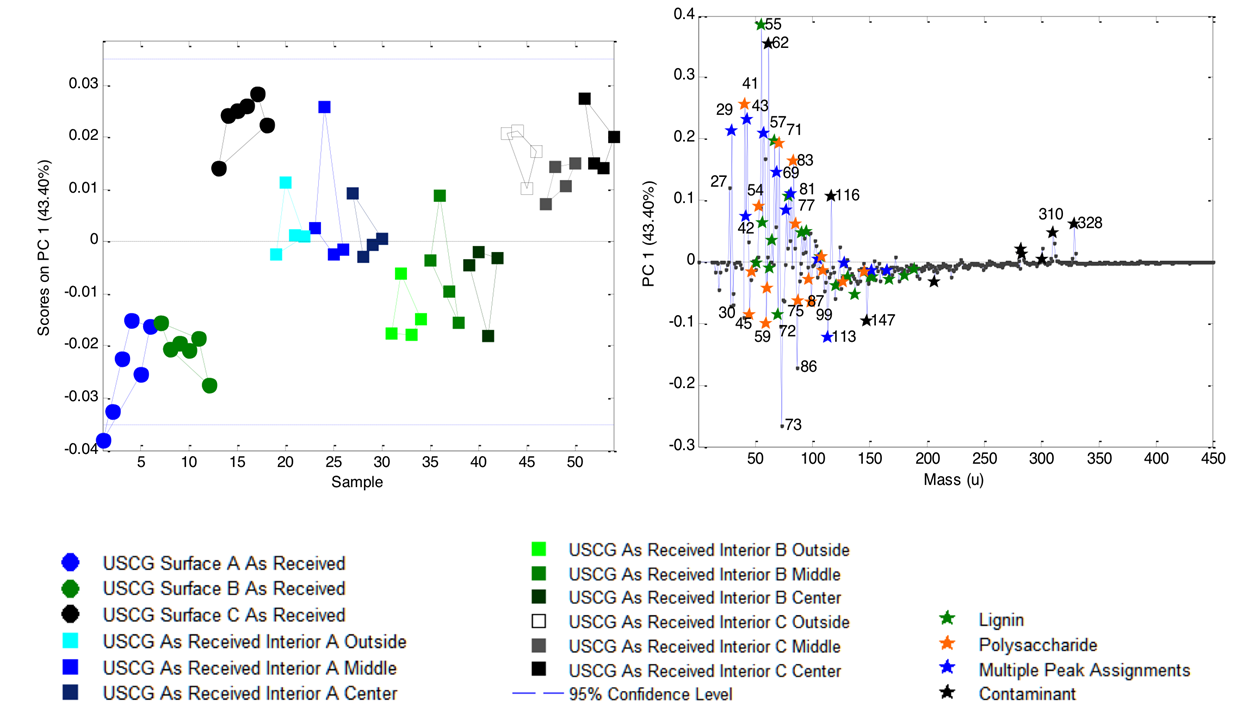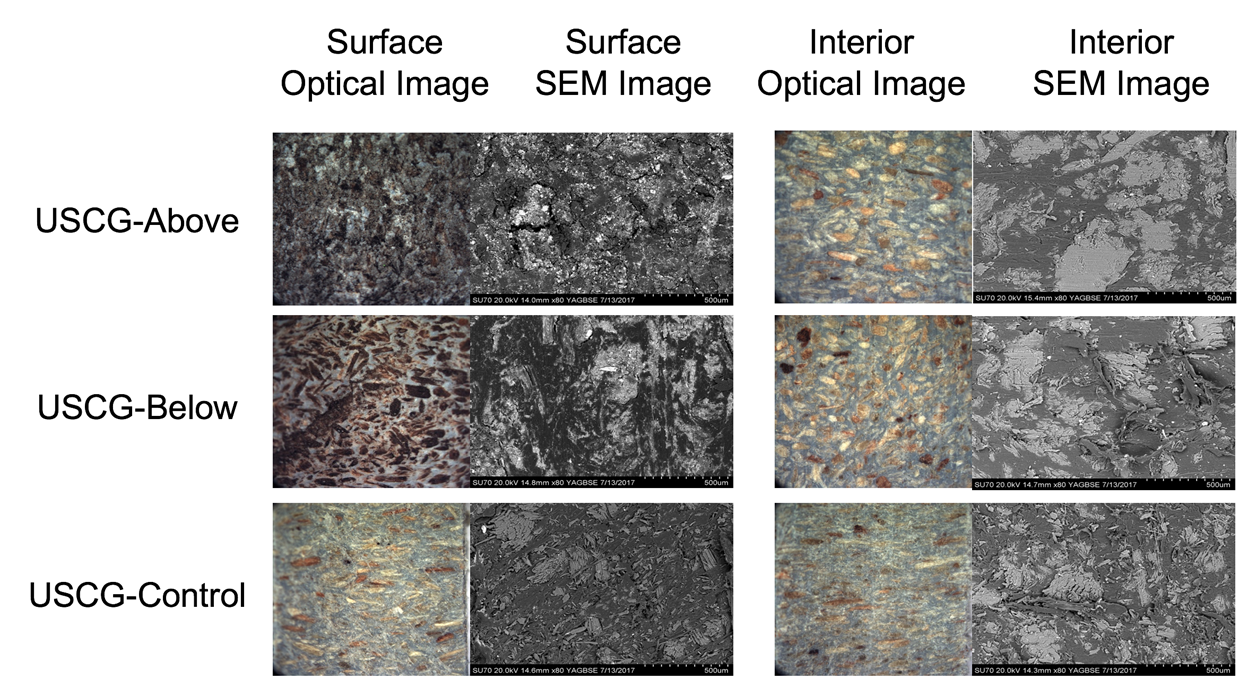Reports: UNI555263-UNI5: Studying Weathering Effects at Interfaces Within Wood-Polymer Composites Using Imaging Time-of-Flight Secondary Ion Mass Spectrometry (ToF-SIMS)
Robyn E. Goacher, PhD, Niagara University
Background
Wood Polymer Composites (WPCs) are a promising material with improved properties over wood or plastic alone. WPCs are common in outdoor applications such as decking and in automotive panels. They allow for the recycling of plastics and reclaimed wood, resulting in the promotion of WPCs as environmentally friendly. WPCs are, however, relatively new materials and current product development research targets increased WPC strength along with many other features: the addition of anti-microbial and anti-fungal properties; and increased resistance to fire, moisture absorption, thermal expansion and degradation due to UV light.
It is important to understand the interface of the hydrophilic wood and hydrophobic thermoplastics used in WPCs, and any migration, blooming or diffusion effects caused by weathering. In this research, we aimed to expand this understanding by using Time-of-Flight Secondary Ion Mass Spectrometry (ToF-SIMS), which is a surface sensitive mass spectrometry technique with high spatial resolution. During the first year of funding, a method was developed to clean and remove excess surface contamination due to handling and production. This method was then applied to WPCs made with varying polymer types.
The goals of the second year of grant funding were to: 1) analyze a set of samples that had been naturally weathered outdoors for a period of 10 years, and 2) apply several complementary techniques to better understand the chemical and physical changes occurring during the weathering process.
Naturally Weathered WPC Samples
Naturally weathered samples were obtained from the Advanced Structures and Composites Center at the University of Maine. These samples had been weathered “above” and “below” ground for a period of 10 years. A “control” sample was stored for 10 years to avoid degradation over time. WPC materials treated in this way included brown and green float rope and a sample used by the United States Coast Guard (USCG). The surface of each sample was removed and 6 replicate spectra were obtained with ToF-SIMS. Each sample was also cut to expose the central interior cross-section (about 1-inch wide), across which ToF-SIMS replicates were taken to obtain 4 replicates near the outer edges of the interior, 4 replicates near the center of the interior, and 4 replicates intermediate between these interior positions. This was to examine potential leaching or degradation into the bulk of the WPCs.
Principal Component Analysis (PCA) was used to compare these ToF-SIMS spectra, where the weathered surfaces were different for all samples, but the USCG sample showed further distinction of below-ground interior samples (Figure 1). The control surface (black circles) grouped with the control and above-ground interiors (blue and black squares), scoring positive on Principal Component 1 (PC 1, Figure 1A). However, the weathered surface samples (blue and green circles) and below-ground interiors grouped oppositely, negative on PC1 (Fig. 1A). This indicated that weathering caused the loss of lubricants (62, 116, 282, 310, and 328u) and polymer (29, 43, 57, and 69u), which loaded positive on PC1 (Fig. 1B) for both the weathered surface and below-ground interior samples.
Figure 1: PCA scores and loadings showing components identified among positive ToF-SIMS spectra from the USCG polymer samples.
Use of Complementary Techniques
Scanning Electron Microscopy with Energy-Dispersive X-ray Spectroscopy (SEM-EDS), Optical Microscopy, and Fourier Transform Infrared Spectroscopy (FTIR) were employed as complementary techniques to augment the ToF-SIMS studies of the changes that occurred to the WPCs during the weathering process. Backscattered SEM provided contrast between the wood and polymer phases (Figure 2) that confirmed the interiors of the samples to be more wood-rich than the surfaces, and which confirmed the loss of polymer from the surface during weathering. Furthermore, SEM-EDS allowed for the identification of bright regions in the backscattered electron images as aluminosilicate minerals (dirt), providing inorganic analysis more easily than the ToF-SIMS.
Optical microscopy provided similar information to the SEM, indicating the coverage of wood and dirt (Figure 2) and confirming the loss of polymer from the surfaces of the WPCs with weathering, particularly for the brown and green float rope samples (data not shown). SEM and optical images were unable to identify differences between interior samples, whereas differences were evident in the ToF-SIMS spectra (Figure 1). FTIR spectra (not shown) revealed few differences between the samples, which can be explained by coverage of dirt on the sample surfaces. For example, the weathered surface samples had reduced intensity for the C=C stretch around 1744cm-1 and for several C-H stretching peaks. The reduction of these peaks in the above- and below-ground surface samples could indicate that the peaks due to lignin and polymer were covered up by accumulation of minerals, or were cleaved and lost during weathering.
Figure 2: Representative optical and backscattered scanning electron microscopy (SEM) images of USCG WPC samples. Optical images obtained using a Nikon SMZ-U microscope at a scale of 1:10. SEM images obtained using a Hitachi SU-70 SEM at 80x magnification and 20kV energy.
Ongoing and Future Work
Now that ToF-SIMS spectra have been obtained and compared between samples that were naturally aged for ten years, the USCG sample has been identified as particularly interesting due to the altered interior of the below-ground sample. The USCG sample will be the priority for ongoing work, which will focus on the more time-intensive step of collecting high resolution ToF-SIMS chemical images. These chemical images will hopefully permit a better understanding of the interface between wood and polymer in the WPCs. Furthermore, X-ray photoelectron spectroscopy (XPS) is being added as another complementary technique, to compare to ToF-SIMS, and to further enable the understanding of how wood and polymer interact in WPCs before and after weathering.
Impact on Students and PI
To date, five undergraduate students participated in the design and execution of this project, gaining advanced instrument and data analysis experience. Students gained individual and teamwork skills, and presented their results at regional and national conferences, including international meetings of the American Chemical Society and American Vacuum Society. The grant has substantially furthered the progress of this project and enabled students to dedicate their time to research.













